User Interface, Modularity, Design Choices, and Platform Leadership
VerifiedAdded on 2022/12/19
|10
|2993
|52
Report
AI Summary
This report delves into the intricacies of user interface (UI) design and modularity, exploring their significance in software and operating system development. It examines the role of UI in enhancing user experience and brand value, particularly in competitive markets. The report discusses the concepts of modularity, interfaces, and their impact on platform leadership, analyzing the relationship between modular design choices and platform leadership within the context of technological advancements. It highlights the importance of modular architecture, standard and interdependent interfaces, and the application of modularity in technology and management. The report emphasizes how modular design and product platforms can enhance a company's portfolio, reduce costs, and improve the design process, ultimately contributing to platform leadership and strategic management within an organization. The report also discusses the benefits of adopting a platform and module strategy in product development.

Question 2
Paraphrase This Document
Need a fresh take? Get an instant paraphrase of this document with our AI Paraphraser
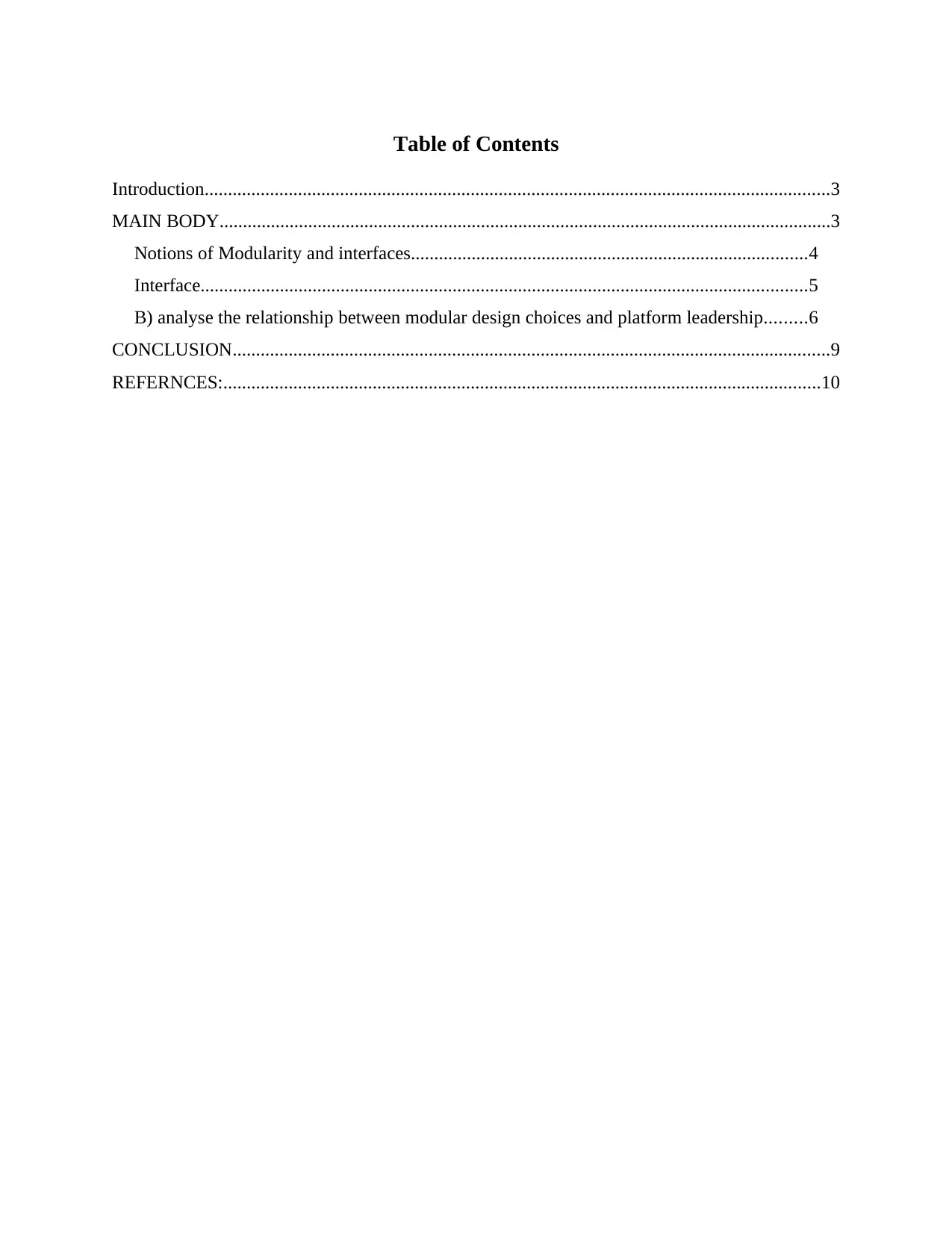
Table of Contents
Introduction......................................................................................................................................3
MAIN BODY...................................................................................................................................3
Notions of Modularity and interfaces.....................................................................................4
Interface..................................................................................................................................5
B) analyse the relationship between modular design choices and platform leadership.........6
CONCLUSION................................................................................................................................9
REFERNCES:................................................................................................................................10
Introduction......................................................................................................................................3
MAIN BODY...................................................................................................................................3
Notions of Modularity and interfaces.....................................................................................4
Interface..................................................................................................................................5
B) analyse the relationship between modular design choices and platform leadership.........6
CONCLUSION................................................................................................................................9
REFERNCES:................................................................................................................................10
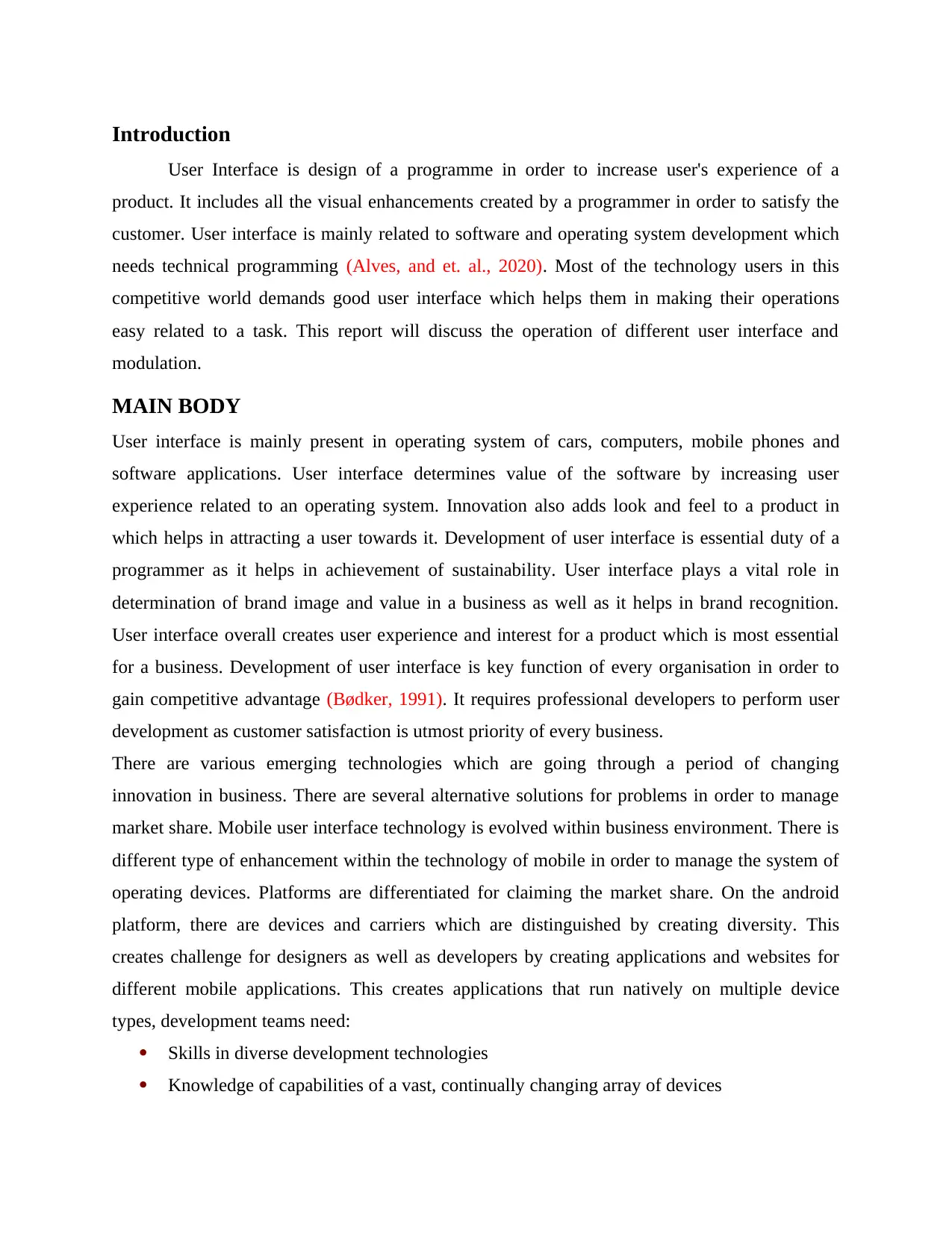
Introduction
User Interface is design of a programme in order to increase user's experience of a
product. It includes all the visual enhancements created by a programmer in order to satisfy the
customer. User interface is mainly related to software and operating system development which
needs technical programming (Alves, and et. al., 2020). Most of the technology users in this
competitive world demands good user interface which helps them in making their operations
easy related to a task. This report will discuss the operation of different user interface and
modulation.
MAIN BODY
User interface is mainly present in operating system of cars, computers, mobile phones and
software applications. User interface determines value of the software by increasing user
experience related to an operating system. Innovation also adds look and feel to a product in
which helps in attracting a user towards it. Development of user interface is essential duty of a
programmer as it helps in achievement of sustainability. User interface plays a vital role in
determination of brand image and value in a business as well as it helps in brand recognition.
User interface overall creates user experience and interest for a product which is most essential
for a business. Development of user interface is key function of every organisation in order to
gain competitive advantage (Bødker, 1991). It requires professional developers to perform user
development as customer satisfaction is utmost priority of every business.
There are various emerging technologies which are going through a period of changing
innovation in business. There are several alternative solutions for problems in order to manage
market share. Mobile user interface technology is evolved within business environment. There is
different type of enhancement within the technology of mobile in order to manage the system of
operating devices. Platforms are differentiated for claiming the market share. On the android
platform, there are devices and carriers which are distinguished by creating diversity. This
creates challenge for designers as well as developers by creating applications and websites for
different mobile applications. This creates applications that run natively on multiple device
types, development teams need:
Skills in diverse development technologies
Knowledge of capabilities of a vast, continually changing array of devices
User Interface is design of a programme in order to increase user's experience of a
product. It includes all the visual enhancements created by a programmer in order to satisfy the
customer. User interface is mainly related to software and operating system development which
needs technical programming (Alves, and et. al., 2020). Most of the technology users in this
competitive world demands good user interface which helps them in making their operations
easy related to a task. This report will discuss the operation of different user interface and
modulation.
MAIN BODY
User interface is mainly present in operating system of cars, computers, mobile phones and
software applications. User interface determines value of the software by increasing user
experience related to an operating system. Innovation also adds look and feel to a product in
which helps in attracting a user towards it. Development of user interface is essential duty of a
programmer as it helps in achievement of sustainability. User interface plays a vital role in
determination of brand image and value in a business as well as it helps in brand recognition.
User interface overall creates user experience and interest for a product which is most essential
for a business. Development of user interface is key function of every organisation in order to
gain competitive advantage (Bødker, 1991). It requires professional developers to perform user
development as customer satisfaction is utmost priority of every business.
There are various emerging technologies which are going through a period of changing
innovation in business. There are several alternative solutions for problems in order to manage
market share. Mobile user interface technology is evolved within business environment. There is
different type of enhancement within the technology of mobile in order to manage the system of
operating devices. Platforms are differentiated for claiming the market share. On the android
platform, there are devices and carriers which are distinguished by creating diversity. This
creates challenge for designers as well as developers by creating applications and websites for
different mobile applications. This creates applications that run natively on multiple device
types, development teams need:
Skills in diverse development technologies
Knowledge of capabilities of a vast, continually changing array of devices
⊘ This is a preview!⊘
Do you want full access?
Subscribe today to unlock all pages.

Trusted by 1+ million students worldwide
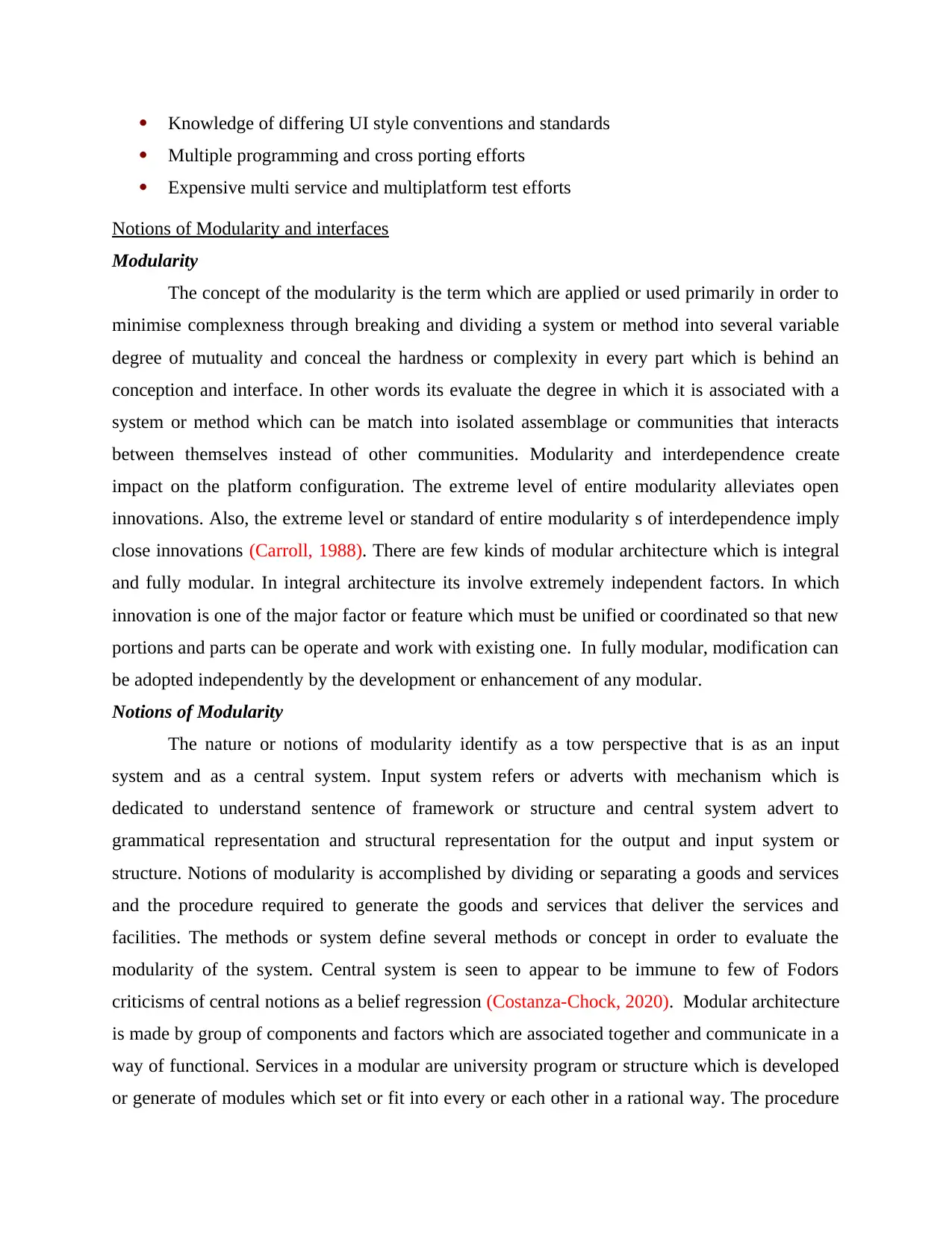
Knowledge of differing UI style conventions and standards
Multiple programming and cross porting efforts
Expensive multi service and multiplatform test efforts
Notions of Modularity and interfaces
Modularity
The concept of the modularity is the term which are applied or used primarily in order to
minimise complexness through breaking and dividing a system or method into several variable
degree of mutuality and conceal the hardness or complexity in every part which is behind an
conception and interface. In other words its evaluate the degree in which it is associated with a
system or method which can be match into isolated assemblage or communities that interacts
between themselves instead of other communities. Modularity and interdependence create
impact on the platform configuration. The extreme level of entire modularity alleviates open
innovations. Also, the extreme level or standard of entire modularity s of interdependence imply
close innovations (Carroll, 1988). There are few kinds of modular architecture which is integral
and fully modular. In integral architecture its involve extremely independent factors. In which
innovation is one of the major factor or feature which must be unified or coordinated so that new
portions and parts can be operate and work with existing one. In fully modular, modification can
be adopted independently by the development or enhancement of any modular.
Notions of Modularity
The nature or notions of modularity identify as a tow perspective that is as an input
system and as a central system. Input system refers or adverts with mechanism which is
dedicated to understand sentence of framework or structure and central system advert to
grammatical representation and structural representation for the output and input system or
structure. Notions of modularity is accomplished by dividing or separating a goods and services
and the procedure required to generate the goods and services that deliver the services and
facilities. The methods or system define several methods or concept in order to evaluate the
modularity of the system. Central system is seen to appear to be immune to few of Fodors
criticisms of central notions as a belief regression (Costanza-Chock, 2020). Modular architecture
is made by group of components and factors which are associated together and communicate in a
way of functional. Services in a modular are university program or structure which is developed
or generate of modules which set or fit into every or each other in a rational way. The procedure
Multiple programming and cross porting efforts
Expensive multi service and multiplatform test efforts
Notions of Modularity and interfaces
Modularity
The concept of the modularity is the term which are applied or used primarily in order to
minimise complexness through breaking and dividing a system or method into several variable
degree of mutuality and conceal the hardness or complexity in every part which is behind an
conception and interface. In other words its evaluate the degree in which it is associated with a
system or method which can be match into isolated assemblage or communities that interacts
between themselves instead of other communities. Modularity and interdependence create
impact on the platform configuration. The extreme level of entire modularity alleviates open
innovations. Also, the extreme level or standard of entire modularity s of interdependence imply
close innovations (Carroll, 1988). There are few kinds of modular architecture which is integral
and fully modular. In integral architecture its involve extremely independent factors. In which
innovation is one of the major factor or feature which must be unified or coordinated so that new
portions and parts can be operate and work with existing one. In fully modular, modification can
be adopted independently by the development or enhancement of any modular.
Notions of Modularity
The nature or notions of modularity identify as a tow perspective that is as an input
system and as a central system. Input system refers or adverts with mechanism which is
dedicated to understand sentence of framework or structure and central system advert to
grammatical representation and structural representation for the output and input system or
structure. Notions of modularity is accomplished by dividing or separating a goods and services
and the procedure required to generate the goods and services that deliver the services and
facilities. The methods or system define several methods or concept in order to evaluate the
modularity of the system. Central system is seen to appear to be immune to few of Fodors
criticisms of central notions as a belief regression (Costanza-Chock, 2020). Modular architecture
is made by group of components and factors which are associated together and communicate in a
way of functional. Services in a modular are university program or structure which is developed
or generate of modules which set or fit into every or each other in a rational way. The procedure
Paraphrase This Document
Need a fresh take? Get an instant paraphrase of this document with our AI Paraphraser
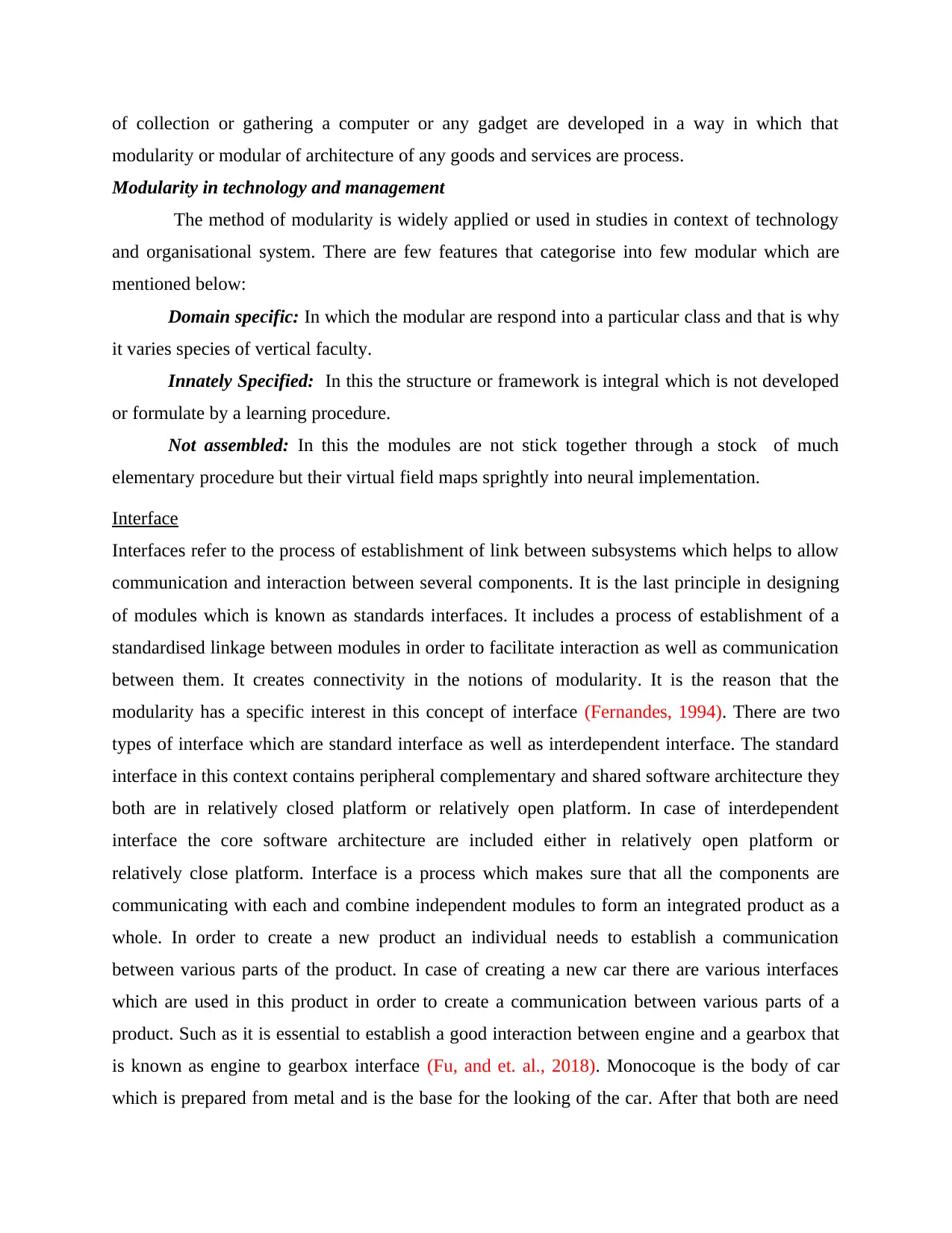
of collection or gathering a computer or any gadget are developed in a way in which that
modularity or modular of architecture of any goods and services are process.
Modularity in technology and management
The method of modularity is widely applied or used in studies in context of technology
and organisational system. There are few features that categorise into few modular which are
mentioned below:
Domain specific: In which the modular are respond into a particular class and that is why
it varies species of vertical faculty.
Innately Specified: In this the structure or framework is integral which is not developed
or formulate by a learning procedure.
Not assembled: In this the modules are not stick together through a stock of much
elementary procedure but their virtual field maps sprightly into neural implementation.
Interface
Interfaces refer to the process of establishment of link between subsystems which helps to allow
communication and interaction between several components. It is the last principle in designing
of modules which is known as standards interfaces. It includes a process of establishment of a
standardised linkage between modules in order to facilitate interaction as well as communication
between them. It creates connectivity in the notions of modularity. It is the reason that the
modularity has a specific interest in this concept of interface (Fernandes, 1994). There are two
types of interface which are standard interface as well as interdependent interface. The standard
interface in this context contains peripheral complementary and shared software architecture they
both are in relatively closed platform or relatively open platform. In case of interdependent
interface the core software architecture are included either in relatively open platform or
relatively close platform. Interface is a process which makes sure that all the components are
communicating with each and combine independent modules to form an integrated product as a
whole. In order to create a new product an individual needs to establish a communication
between various parts of the product. In case of creating a new car there are various interfaces
which are used in this product in order to create a communication between various parts of a
product. Such as it is essential to establish a good interaction between engine and a gearbox that
is known as engine to gearbox interface (Fu, and et. al., 2018). Monocoque is the body of car
which is prepared from metal and is the base for the looking of the car. After that both are need
modularity or modular of architecture of any goods and services are process.
Modularity in technology and management
The method of modularity is widely applied or used in studies in context of technology
and organisational system. There are few features that categorise into few modular which are
mentioned below:
Domain specific: In which the modular are respond into a particular class and that is why
it varies species of vertical faculty.
Innately Specified: In this the structure or framework is integral which is not developed
or formulate by a learning procedure.
Not assembled: In this the modules are not stick together through a stock of much
elementary procedure but their virtual field maps sprightly into neural implementation.
Interface
Interfaces refer to the process of establishment of link between subsystems which helps to allow
communication and interaction between several components. It is the last principle in designing
of modules which is known as standards interfaces. It includes a process of establishment of a
standardised linkage between modules in order to facilitate interaction as well as communication
between them. It creates connectivity in the notions of modularity. It is the reason that the
modularity has a specific interest in this concept of interface (Fernandes, 1994). There are two
types of interface which are standard interface as well as interdependent interface. The standard
interface in this context contains peripheral complementary and shared software architecture they
both are in relatively closed platform or relatively open platform. In case of interdependent
interface the core software architecture are included either in relatively open platform or
relatively close platform. Interface is a process which makes sure that all the components are
communicating with each and combine independent modules to form an integrated product as a
whole. In order to create a new product an individual needs to establish a communication
between various parts of the product. In case of creating a new car there are various interfaces
which are used in this product in order to create a communication between various parts of a
product. Such as it is essential to establish a good interaction between engine and a gearbox that
is known as engine to gearbox interface (Fu, and et. al., 2018). Monocoque is the body of car
which is prepared from metal and is the base for the looking of the car. After that both are need
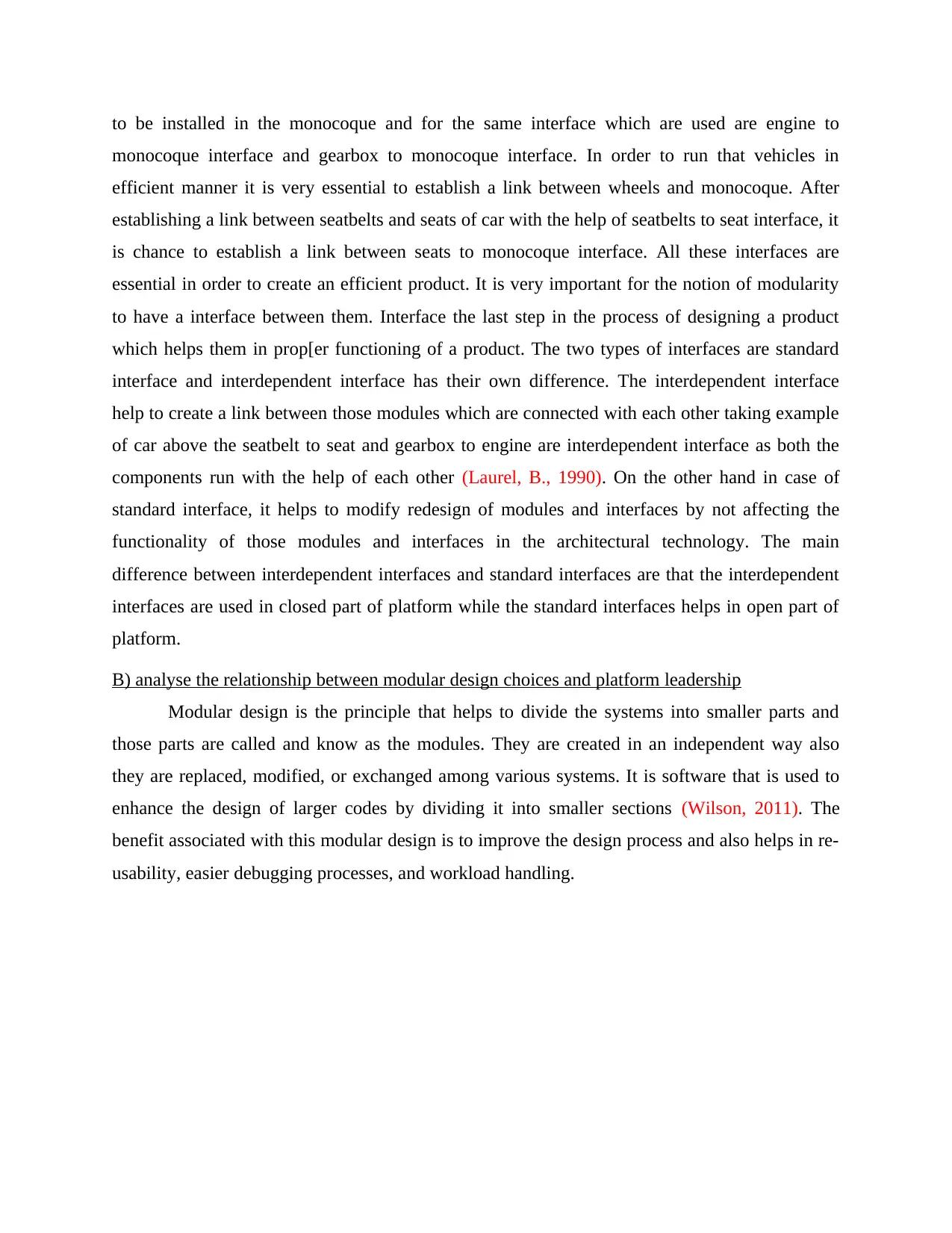
to be installed in the monocoque and for the same interface which are used are engine to
monocoque interface and gearbox to monocoque interface. In order to run that vehicles in
efficient manner it is very essential to establish a link between wheels and monocoque. After
establishing a link between seatbelts and seats of car with the help of seatbelts to seat interface, it
is chance to establish a link between seats to monocoque interface. All these interfaces are
essential in order to create an efficient product. It is very important for the notion of modularity
to have a interface between them. Interface the last step in the process of designing a product
which helps them in prop[er functioning of a product. The two types of interfaces are standard
interface and interdependent interface has their own difference. The interdependent interface
help to create a link between those modules which are connected with each other taking example
of car above the seatbelt to seat and gearbox to engine are interdependent interface as both the
components run with the help of each other (Laurel, B., 1990). On the other hand in case of
standard interface, it helps to modify redesign of modules and interfaces by not affecting the
functionality of those modules and interfaces in the architectural technology. The main
difference between interdependent interfaces and standard interfaces are that the interdependent
interfaces are used in closed part of platform while the standard interfaces helps in open part of
platform.
B) analyse the relationship between modular design choices and platform leadership
Modular design is the principle that helps to divide the systems into smaller parts and
those parts are called and know as the modules. They are created in an independent way also
they are replaced, modified, or exchanged among various systems. It is software that is used to
enhance the design of larger codes by dividing it into smaller sections (Wilson, 2011). The
benefit associated with this modular design is to improve the design process and also helps in re-
usability, easier debugging processes, and workload handling.
monocoque interface and gearbox to monocoque interface. In order to run that vehicles in
efficient manner it is very essential to establish a link between wheels and monocoque. After
establishing a link between seatbelts and seats of car with the help of seatbelts to seat interface, it
is chance to establish a link between seats to monocoque interface. All these interfaces are
essential in order to create an efficient product. It is very important for the notion of modularity
to have a interface between them. Interface the last step in the process of designing a product
which helps them in prop[er functioning of a product. The two types of interfaces are standard
interface and interdependent interface has their own difference. The interdependent interface
help to create a link between those modules which are connected with each other taking example
of car above the seatbelt to seat and gearbox to engine are interdependent interface as both the
components run with the help of each other (Laurel, B., 1990). On the other hand in case of
standard interface, it helps to modify redesign of modules and interfaces by not affecting the
functionality of those modules and interfaces in the architectural technology. The main
difference between interdependent interfaces and standard interfaces are that the interdependent
interfaces are used in closed part of platform while the standard interfaces helps in open part of
platform.
B) analyse the relationship between modular design choices and platform leadership
Modular design is the principle that helps to divide the systems into smaller parts and
those parts are called and know as the modules. They are created in an independent way also
they are replaced, modified, or exchanged among various systems. It is software that is used to
enhance the design of larger codes by dividing it into smaller sections (Wilson, 2011). The
benefit associated with this modular design is to improve the design process and also helps in re-
usability, easier debugging processes, and workload handling.
⊘ This is a preview!⊘
Do you want full access?
Subscribe today to unlock all pages.

Trusted by 1+ million students worldwide
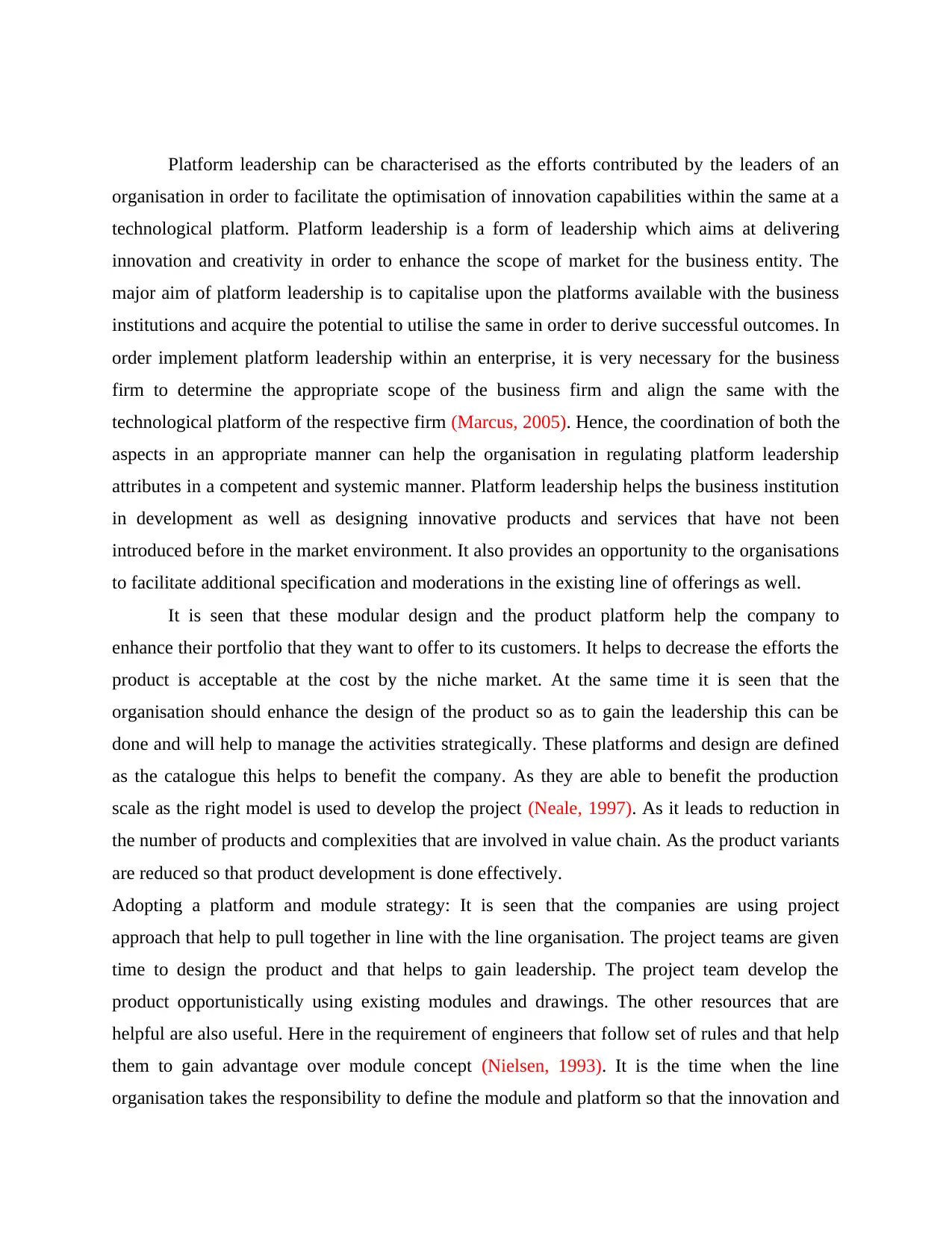
Platform leadership can be characterised as the efforts contributed by the leaders of an
organisation in order to facilitate the optimisation of innovation capabilities within the same at a
technological platform. Platform leadership is a form of leadership which aims at delivering
innovation and creativity in order to enhance the scope of market for the business entity. The
major aim of platform leadership is to capitalise upon the platforms available with the business
institutions and acquire the potential to utilise the same in order to derive successful outcomes. In
order implement platform leadership within an enterprise, it is very necessary for the business
firm to determine the appropriate scope of the business firm and align the same with the
technological platform of the respective firm (Marcus, 2005). Hence, the coordination of both the
aspects in an appropriate manner can help the organisation in regulating platform leadership
attributes in a competent and systemic manner. Platform leadership helps the business institution
in development as well as designing innovative products and services that have not been
introduced before in the market environment. It also provides an opportunity to the organisations
to facilitate additional specification and moderations in the existing line of offerings as well.
It is seen that these modular design and the product platform help the company to
enhance their portfolio that they want to offer to its customers. It helps to decrease the efforts the
product is acceptable at the cost by the niche market. At the same time it is seen that the
organisation should enhance the design of the product so as to gain the leadership this can be
done and will help to manage the activities strategically. These platforms and design are defined
as the catalogue this helps to benefit the company. As they are able to benefit the production
scale as the right model is used to develop the project (Neale, 1997). As it leads to reduction in
the number of products and complexities that are involved in value chain. As the product variants
are reduced so that product development is done effectively.
Adopting a platform and module strategy: It is seen that the companies are using project
approach that help to pull together in line with the line organisation. The project teams are given
time to design the product and that helps to gain leadership. The project team develop the
product opportunistically using existing modules and drawings. The other resources that are
helpful are also useful. Here in the requirement of engineers that follow set of rules and that help
them to gain advantage over module concept (Nielsen, 1993). It is the time when the line
organisation takes the responsibility to define the module and platform so that the innovation and
organisation in order to facilitate the optimisation of innovation capabilities within the same at a
technological platform. Platform leadership is a form of leadership which aims at delivering
innovation and creativity in order to enhance the scope of market for the business entity. The
major aim of platform leadership is to capitalise upon the platforms available with the business
institutions and acquire the potential to utilise the same in order to derive successful outcomes. In
order implement platform leadership within an enterprise, it is very necessary for the business
firm to determine the appropriate scope of the business firm and align the same with the
technological platform of the respective firm (Marcus, 2005). Hence, the coordination of both the
aspects in an appropriate manner can help the organisation in regulating platform leadership
attributes in a competent and systemic manner. Platform leadership helps the business institution
in development as well as designing innovative products and services that have not been
introduced before in the market environment. It also provides an opportunity to the organisations
to facilitate additional specification and moderations in the existing line of offerings as well.
It is seen that these modular design and the product platform help the company to
enhance their portfolio that they want to offer to its customers. It helps to decrease the efforts the
product is acceptable at the cost by the niche market. At the same time it is seen that the
organisation should enhance the design of the product so as to gain the leadership this can be
done and will help to manage the activities strategically. These platforms and design are defined
as the catalogue this helps to benefit the company. As they are able to benefit the production
scale as the right model is used to develop the project (Neale, 1997). As it leads to reduction in
the number of products and complexities that are involved in value chain. As the product variants
are reduced so that product development is done effectively.
Adopting a platform and module strategy: It is seen that the companies are using project
approach that help to pull together in line with the line organisation. The project teams are given
time to design the product and that helps to gain leadership. The project team develop the
product opportunistically using existing modules and drawings. The other resources that are
helpful are also useful. Here in the requirement of engineers that follow set of rules and that help
them to gain advantage over module concept (Nielsen, 1993). It is the time when the line
organisation takes the responsibility to define the module and platform so that the innovation and
Paraphrase This Document
Need a fresh take? Get an instant paraphrase of this document with our AI Paraphraser
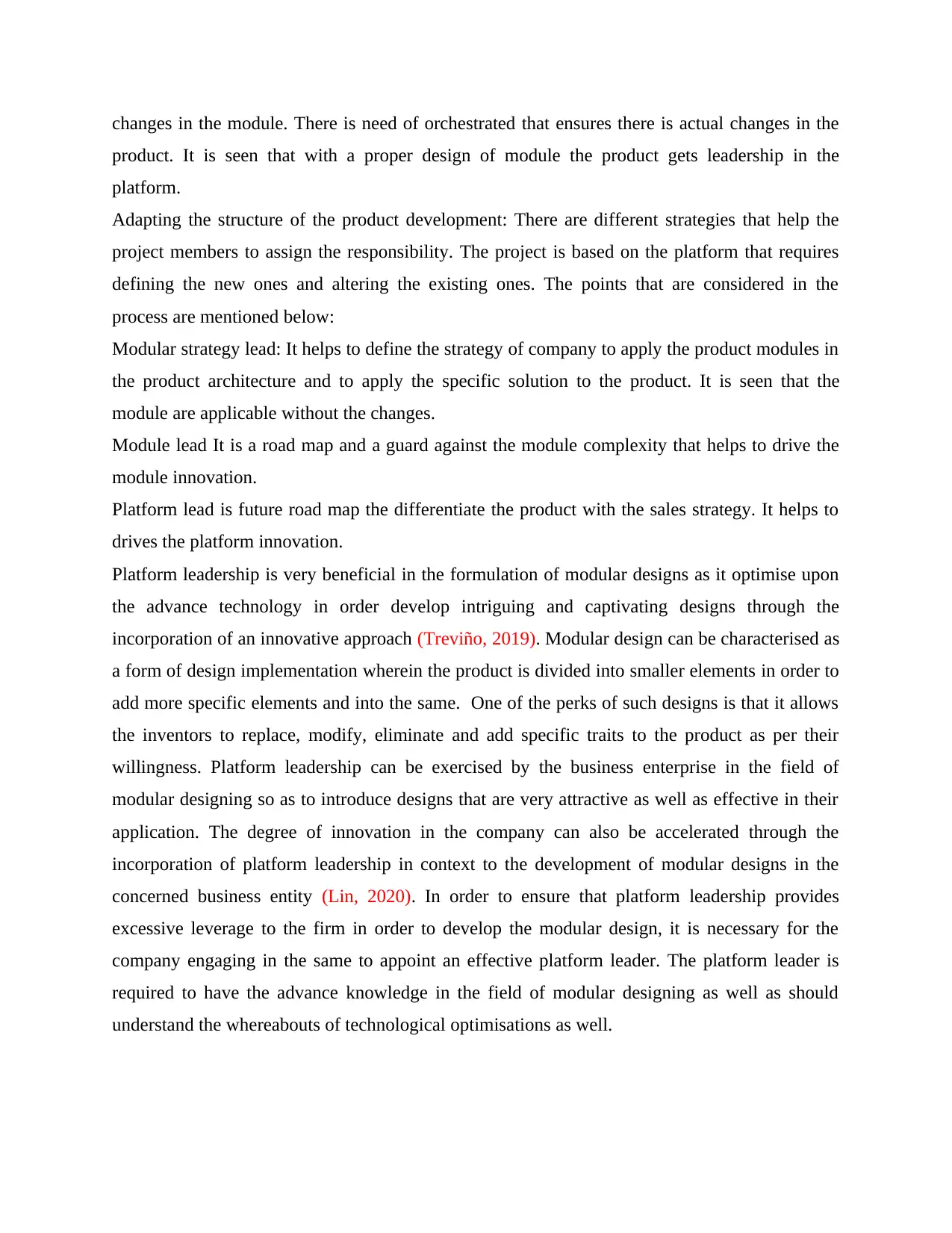
changes in the module. There is need of orchestrated that ensures there is actual changes in the
product. It is seen that with a proper design of module the product gets leadership in the
platform.
Adapting the structure of the product development: There are different strategies that help the
project members to assign the responsibility. The project is based on the platform that requires
defining the new ones and altering the existing ones. The points that are considered in the
process are mentioned below:
Modular strategy lead: It helps to define the strategy of company to apply the product modules in
the product architecture and to apply the specific solution to the product. It is seen that the
module are applicable without the changes.
Module lead It is a road map and a guard against the module complexity that helps to drive the
module innovation.
Platform lead is future road map the differentiate the product with the sales strategy. It helps to
drives the platform innovation.
Platform leadership is very beneficial in the formulation of modular designs as it optimise upon
the advance technology in order develop intriguing and captivating designs through the
incorporation of an innovative approach (Treviño, 2019). Modular design can be characterised as
a form of design implementation wherein the product is divided into smaller elements in order to
add more specific elements and into the same. One of the perks of such designs is that it allows
the inventors to replace, modify, eliminate and add specific traits to the product as per their
willingness. Platform leadership can be exercised by the business enterprise in the field of
modular designing so as to introduce designs that are very attractive as well as effective in their
application. The degree of innovation in the company can also be accelerated through the
incorporation of platform leadership in context to the development of modular designs in the
concerned business entity (Lin, 2020). In order to ensure that platform leadership provides
excessive leverage to the firm in order to develop the modular design, it is necessary for the
company engaging in the same to appoint an effective platform leader. The platform leader is
required to have the advance knowledge in the field of modular designing as well as should
understand the whereabouts of technological optimisations as well.
product. It is seen that with a proper design of module the product gets leadership in the
platform.
Adapting the structure of the product development: There are different strategies that help the
project members to assign the responsibility. The project is based on the platform that requires
defining the new ones and altering the existing ones. The points that are considered in the
process are mentioned below:
Modular strategy lead: It helps to define the strategy of company to apply the product modules in
the product architecture and to apply the specific solution to the product. It is seen that the
module are applicable without the changes.
Module lead It is a road map and a guard against the module complexity that helps to drive the
module innovation.
Platform lead is future road map the differentiate the product with the sales strategy. It helps to
drives the platform innovation.
Platform leadership is very beneficial in the formulation of modular designs as it optimise upon
the advance technology in order develop intriguing and captivating designs through the
incorporation of an innovative approach (Treviño, 2019). Modular design can be characterised as
a form of design implementation wherein the product is divided into smaller elements in order to
add more specific elements and into the same. One of the perks of such designs is that it allows
the inventors to replace, modify, eliminate and add specific traits to the product as per their
willingness. Platform leadership can be exercised by the business enterprise in the field of
modular designing so as to introduce designs that are very attractive as well as effective in their
application. The degree of innovation in the company can also be accelerated through the
incorporation of platform leadership in context to the development of modular designs in the
concerned business entity (Lin, 2020). In order to ensure that platform leadership provides
excessive leverage to the firm in order to develop the modular design, it is necessary for the
company engaging in the same to appoint an effective platform leader. The platform leader is
required to have the advance knowledge in the field of modular designing as well as should
understand the whereabouts of technological optimisations as well.
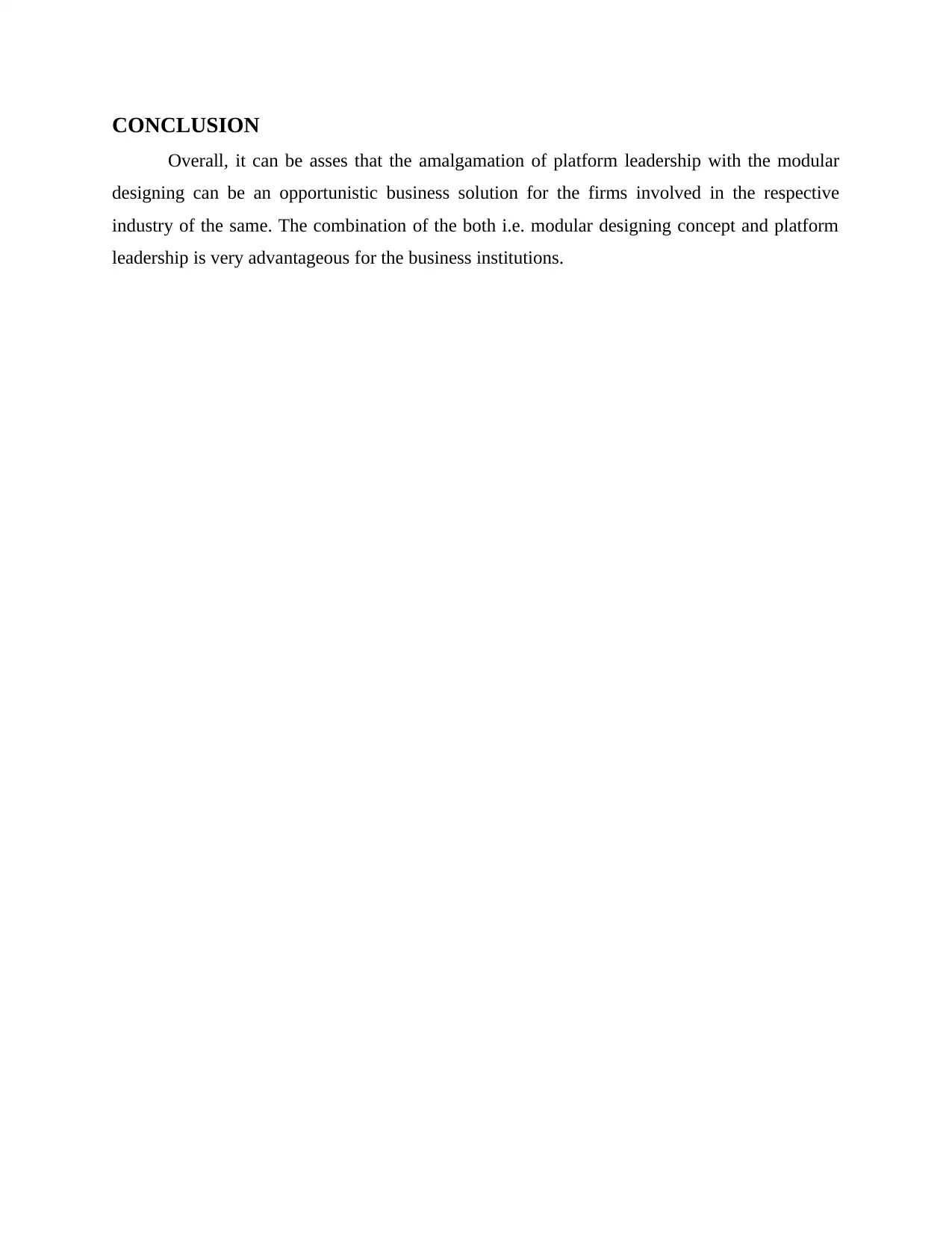
CONCLUSION
Overall, it can be asses that the amalgamation of platform leadership with the modular
designing can be an opportunistic business solution for the firms involved in the respective
industry of the same. The combination of the both i.e. modular designing concept and platform
leadership is very advantageous for the business institutions.
Overall, it can be asses that the amalgamation of platform leadership with the modular
designing can be an opportunistic business solution for the firms involved in the respective
industry of the same. The combination of the both i.e. modular designing concept and platform
leadership is very advantageous for the business institutions.
⊘ This is a preview!⊘
Do you want full access?
Subscribe today to unlock all pages.

Trusted by 1+ million students worldwide
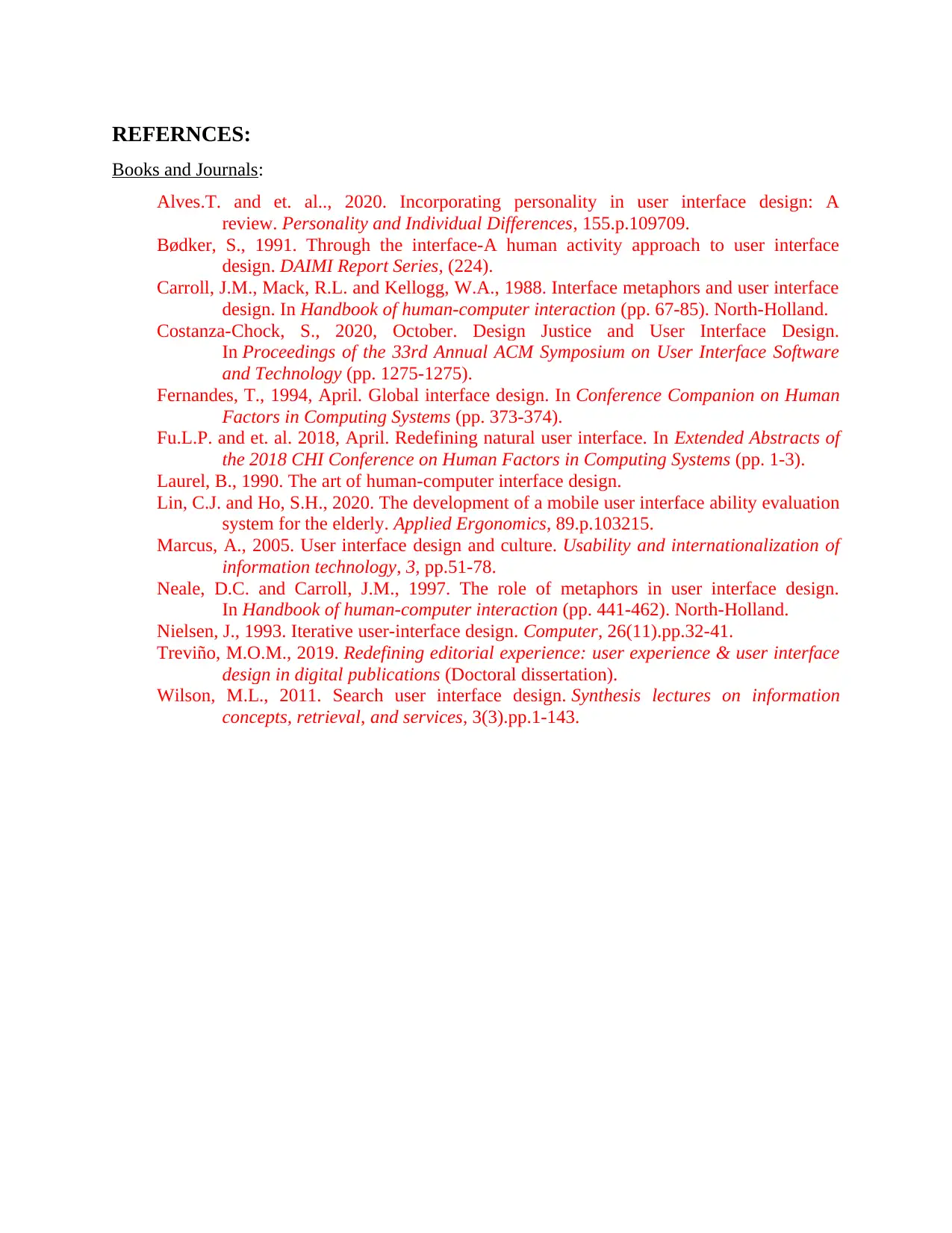
REFERNCES:
Books and Journals:
Alves.T. and et. al.., 2020. Incorporating personality in user interface design: A
review. Personality and Individual Differences, 155.p.109709.
Bødker, S., 1991. Through the interface-A human activity approach to user interface
design. DAIMI Report Series, (224).
Carroll, J.M., Mack, R.L. and Kellogg, W.A., 1988. Interface metaphors and user interface
design. In Handbook of human-computer interaction (pp. 67-85). North-Holland.
Costanza-Chock, S., 2020, October. Design Justice and User Interface Design.
In Proceedings of the 33rd Annual ACM Symposium on User Interface Software
and Technology (pp. 1275-1275).
Fernandes, T., 1994, April. Global interface design. In Conference Companion on Human
Factors in Computing Systems (pp. 373-374).
Fu.L.P. and et. al. 2018, April. Redefining natural user interface. In Extended Abstracts of
the 2018 CHI Conference on Human Factors in Computing Systems (pp. 1-3).
Laurel, B., 1990. The art of human-computer interface design.
Lin, C.J. and Ho, S.H., 2020. The development of a mobile user interface ability evaluation
system for the elderly. Applied Ergonomics, 89.p.103215.
Marcus, A., 2005. User interface design and culture. Usability and internationalization of
information technology, 3, pp.51-78.
Neale, D.C. and Carroll, J.M., 1997. The role of metaphors in user interface design.
In Handbook of human-computer interaction (pp. 441-462). North-Holland.
Nielsen, J., 1993. Iterative user-interface design. Computer, 26(11).pp.32-41.
Treviño, M.O.M., 2019. Redefining editorial experience: user experience & user interface
design in digital publications (Doctoral dissertation).
Wilson, M.L., 2011. Search user interface design. Synthesis lectures on information
concepts, retrieval, and services, 3(3).pp.1-143.
Books and Journals:
Alves.T. and et. al.., 2020. Incorporating personality in user interface design: A
review. Personality and Individual Differences, 155.p.109709.
Bødker, S., 1991. Through the interface-A human activity approach to user interface
design. DAIMI Report Series, (224).
Carroll, J.M., Mack, R.L. and Kellogg, W.A., 1988. Interface metaphors and user interface
design. In Handbook of human-computer interaction (pp. 67-85). North-Holland.
Costanza-Chock, S., 2020, October. Design Justice and User Interface Design.
In Proceedings of the 33rd Annual ACM Symposium on User Interface Software
and Technology (pp. 1275-1275).
Fernandes, T., 1994, April. Global interface design. In Conference Companion on Human
Factors in Computing Systems (pp. 373-374).
Fu.L.P. and et. al. 2018, April. Redefining natural user interface. In Extended Abstracts of
the 2018 CHI Conference on Human Factors in Computing Systems (pp. 1-3).
Laurel, B., 1990. The art of human-computer interface design.
Lin, C.J. and Ho, S.H., 2020. The development of a mobile user interface ability evaluation
system for the elderly. Applied Ergonomics, 89.p.103215.
Marcus, A., 2005. User interface design and culture. Usability and internationalization of
information technology, 3, pp.51-78.
Neale, D.C. and Carroll, J.M., 1997. The role of metaphors in user interface design.
In Handbook of human-computer interaction (pp. 441-462). North-Holland.
Nielsen, J., 1993. Iterative user-interface design. Computer, 26(11).pp.32-41.
Treviño, M.O.M., 2019. Redefining editorial experience: user experience & user interface
design in digital publications (Doctoral dissertation).
Wilson, M.L., 2011. Search user interface design. Synthesis lectures on information
concepts, retrieval, and services, 3(3).pp.1-143.
1 out of 10
Related Documents
Your All-in-One AI-Powered Toolkit for Academic Success.
+13062052269
info@desklib.com
Available 24*7 on WhatsApp / Email
![[object Object]](/_next/static/media/star-bottom.7253800d.svg)
Unlock your academic potential
Copyright © 2020–2025 A2Z Services. All Rights Reserved. Developed and managed by ZUCOL.





